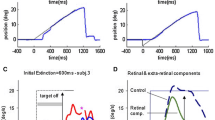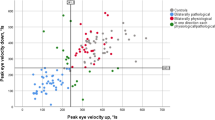Abstract
In multiple sclerosis (MS), randomly located demyelination lesions may involve a large part of the central nervous system and disturb oculomotor activity, including impairment of saccadic and pursuit systems. The aim of the work was to determine the frequency of smooth pursuit disturbances in MS patients and assess the feasibility of various methods for smooth pursuit assessment: the clinical bedside examination and quantitative electrooculographic (EOG) recordings. In addition, we analyzed the effects of age on the results of smooth pursuit tests. Sixty MS patients and 50 volunteers underwent clinical bedside examination and EOG evaluation in a tertiary referral university hospital. EOG recordings of smooth pursuit tests with 0.3, 0.4, 0.5 and 15 Hz amplitude and gain calculation were preformed. In clinical bedside examination, disorders were found in 25%, and with EOG in 76.6% of patients. In the MS patients and subgroups the mean gain for all frequencies were significantly lower compared with the control group. There were significant differences in gain between younger and older subjects in the control group but no significance in all MS patients their subgroups. Patients with abnormalities in clinical bedside examination had poorer results in EOG tests. There were correlations between gain values and Expanded Disability Status Scale score in MS patients. Smooth pursuit examination provides a valuable parameter of brain dysfunction in MS patients. The EOG test is more useful in detecting subclinical cases than clinical bedside examination, and is not affected by test paradigm or age in MS patients.

Similar content being viewed by others
References
Amstrong RA (1999) Multiple sclerosis and the eye. Ophtal Physiol Opt 2:32–42
Frohman EM, Frohman TC, Zee DS, McColl R, Galetta S (2005) The neuroophthalmology of multiple sclerosis. Lancet Neurol 4:111–121
Compston C, Coles A (2008) Multiple sclerosis. Lancet 372:1502–1517
Niestroy A, Rucker JC, Leigh RJ (2007) Neuro-ophthalmologic aspects of multiple sclerosis: using eye movements as a clinical and experimental tool. Clin Ophthalmol 1:267–272
De Seze J, Vukusic S, Viallet-Marcel M et al (2006) Unusual ocular motor findings in multiple sclerosis. J Neurol Sci 243:91–95
Williams NP, Roland PS, Yellin W (1997) Vestibular evaluation in patients with early multiple sclerosis. Am J Otol 18:93–100
Alpini D, Caputo D, Pugnetti L et al (2001) Vertigo and multiple sclerosis: aspects of differential diagnosis. Neurol Sci 22:84–87
Noseworthy JH, Lucchinetti C, Rodriguez M, Weinshenker BG (2000) Multiple sclerosis. N Engl J Med 343:935–938
Barnes D, McDonald WI (1992) The ocular manifestations of multiple sclerosis. J Neurol Neurosurg Psychiatry 55:863–868
Jozefowicz-Korczynska M, Lukomski M, Pajor A (2008) Identification of internuclear ophtalmoplegia signs in multiple sclerosis patients––saccade test analysis. J Neurol 255:1006–1011
Gagnon D, Paus T, Grosbras MH et al (2006) Transcranial magnetic stimulation of frontal oculomotor regions during smooth pursuit. J Neurosci 26:458–566
Müri RM (2006) MRI and fMRI analysis of oculomotor function. Prog Brain Res 15. In: Büttner-Ennever JA (ed) Neuroanatomy of the oculomotor system. Elsevier B.V, Amsterdam, pp 503–526
Bernes GR (2008) Cognitive processes involved in smooth pursuit eye movement. Brain Cogn 68:309–326
Sharpe J, Morrow M (1988) Smooth pursuit disorders. In: Barber HO, Sharpe JA (eds) Physiological and anatomical consideration. Vestibular disorders. Year Book Medical Publishers, Inc., Chicago, pp 129–158
Morrow MJ, Sharpe JA (1995) Deficits of smooth-pursuit eye movement after unilateral frontal lobe lesions. Ann Neurol 37:443–451
Kanajama R, Nakamura T, Sano R, Ohki M, Okuyama T, Kimura Y, Koike Y (1994) Effect of aging on smooth pursuit eye movement. Acta Otolaryngol (Stockh) 511:131–134
Jozefowicz-Korczynska M, Pajor A (2006) Smooth pursuit and saccadic tests outcome in healthy persons in different age. Psychiatria Pol 40:775–786
Leigh RJ, Zee DS (1999) The neurology of eye movement, 3rd edn. Oxford University Press, Inc., New York
McDonald WI, Compston A, Edan G et al (2001) Recommended diagnostic criteria for multiple sclerosis: guidelines from the international panel on the diagnosis of multiple sclerosis. Ann Neurol 50:121–127
Kurtzke JK (1983) Rating neurologic impairment in multiple sclerosis: an expanded disability status scale (EDSS). Neurology 33:1444–1452
Brandt T (2000) Approaching the patients. In: Brandt T (ed) Vertigo. Its multisensory syndromes. Springer, Berlin, pp 23–47
Mastaglia FL, Black JL, Collins DW (1979) Quantitative studies of saccadic and pursuit eye movements in multiple sclerosis. Brain 102:817–834
Meienberg O, Müri RM, Rabineau PA (1986) Clinical and oculographic examinations of saccadic eye movements in the diagnosis of multiple sclerosis. Arch Neurol 43:438–440
Reulen JPH, Sanders EACM, Jogenhuis LAH (1983) Eye movement disorders in multiple sclerosis and optic neuritis. Brain 106:121–140
Solingen LD, Baloh RW, Myers L et al (1977) Subclinical eye movement disorders in patients with multiple sclerosis. Neurology 27:614–619
Derwenskus J, Rucker JC, Serra A et al (2005) Abnormal eye movements predict disability in MS: two-year follow-up. Ann NY Acad Sci 1039:521–523
Leigh RJ, Wolinsky JS (2001) Keeping an eye on MS. Neurology 57:751–752
Serra A, Derwenskus J, Downey DL, Leigh RJ (2003) Role of eye movement examination and subjective visual vertical in clinical evaluation of multiple sclerosis. J Neurol 250:569–575
Jozefowicz-Korczynska M, Durko M, Pajor A (2010) Quantitative ocular-motor test analysis in multiple sclerosis. Otolaryngol Pol 64:147–151
Acknowledgments
The work was supported by Medical University of Lodz, grant no. 502-12-540.
Conflict of interest
None.
Author information
Authors and Affiliations
Corresponding author
Rights and permissions
About this article
Cite this article
Jozefowicz-Korczynska, M., Pajor, A.M. Evaluation of the smooth pursuit tests in multiple sclerosis patients. J Neurol 258, 1795–1800 (2011). https://doi.org/10.1007/s00415-011-6014-0
Received:
Revised:
Accepted:
Published:
Issue Date:
DOI: https://doi.org/10.1007/s00415-011-6014-0




